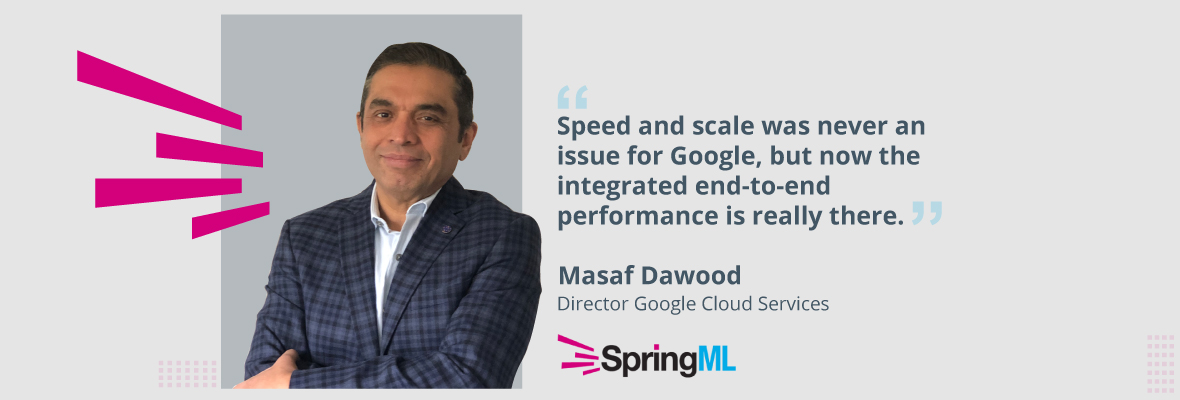Google Cloud has been gaining some noticeable traction in recent months: 43% growth in Q2 is nothing to sniff about, especially during a global recession. Masaf Dawood is director of Google Cloud services with SpringML, a premier Google Cloud partner with specialties in application development, data analytics, machine learning and marketing analytics. SpringML works exclusively with Google Cloud and has worked on 200 engagements with Google since the consultancy was founded in 2015.
SpringML, a launch partner of the Google chatbot called Google Dialogue Flow, develops Google Cloud-based solutions for large enterprises as well as SMBs and public sector clients. The company is currently developing Covid-19 contact tracing apps and is in talks with more than 10 states after launching the Commonwealth of Virginia Contact tracing app. Masaf spoke with us about his perspective on Google Cloud and the potential of AI and machine learning technologies to solve critical business and societal problems.
For one, he’s bullish on Google Cloud’s future because of the maturity in important technologies like Big Query, which he says has one of the highest SLAs in the industry and Google’s acquisition of innovative companies like Looker, which brings easy to use, rapid data visualization. “Speed and scale was never an issue for Google, but now the integrated end-to-end performance is really there,” he says.
Here’s what else Masaf had to say:
OpsRamp: Why did SpringML choose to focus on Google Cloud?
MD: From what I understand, our founders were very attracted to the historical DNA of Google which has centered around high-speed data DNA such as search and ads. Google has always had a focus in AI and machine learning. We loved the techie reputation of Google too, because we are techies. What’s also appealing to us is that Google understands the art of possible. They are not tied to licensing models and they have embraced the vision of open source. By not creating an IP layer, they’ve created high-quality technologies which are highly available to scientists, analysts and developers. Google Kubernetes Engine (GKE) is a great example. It’s now the de facto standard for containers and an enabler of application modernization.
Finally, compared to the other major cloud providers, Google has superior strengths in multi-cloud management with Anthos. You can have a truly hybrid cloud environment. Anthos is still new, but the message is starting to resonate. What it means is that enterprises don’t need multiple teams to manage multiple clouds.
OpsRamp: What’s exciting to you about artificial intelligence and machine learning right now?
MD: One of our clients is a large machinery operator and executives wanted to predict failure on a certain part. We had some paper-based models on statistics which we use to build a machine learning model in Google Cloud. The model collects data from these machines at five-to-15-minute intervals to help predict failure of the part; the metric is called RUL or remainder of useful life. Being accurate with this metric can bring significant savings in budget, significant savings from downtime avoidance and significant reduction in risk of human injury. The goal is to have zero failure. We are also working with companies like Johnson & Johnson on building out diagnostic models for eyecare. The human eye gets tired after looking at a few hundred images but not the machine. These models can deliver high accuracy to predict disease progression.
Today’s IT operations person needs to wear a lot more hats, which includes security and automation, and rely less on intuition for low level issues.”
OpsRamp: How are IT Operations roles changing now?
MD: I used to work in IT Ops, and I’ve seen things change from people responding to notifications on pagers and then Blackberries and later iPhones. Now, people don’t want to look in the rearview mirror. They want to be able to predict issues and have networks that are self-healing. I was just talking to a CTO friend of mine today. He said, why can’t some of these issues be fixed automatically? Nobody can afford downtime but at the same time, nobody can sit at a monitor all day and look for something to break. Humans still need to make the bigger decisions, but they don’t need to do the basic housekeeping. We call it MLOps, and it involves building guardrails for clients and incorporating the SRE concepts which were pioneered by Google. Today’s IT operations person needs to wear a lot more hats, which includes security and automation, and rely less on intuition for low level issues. Of course, a lot of Ops people are still skeptical of automation and machine learning because in the past, the tools have not delivered on the intelligence layer. But now the technology has matured, and the market is ready to embrace these new tools and ways of working.
Next Steps:






